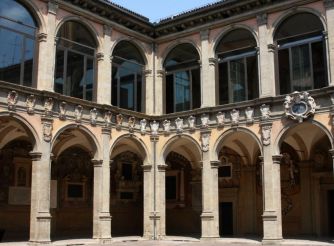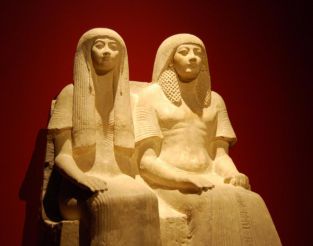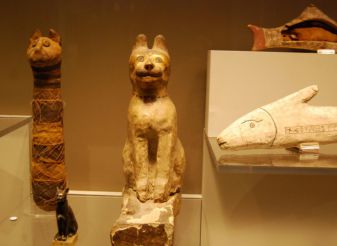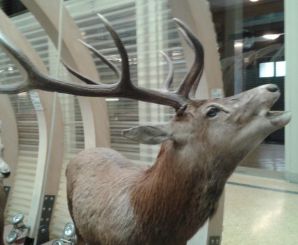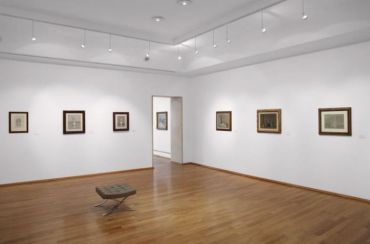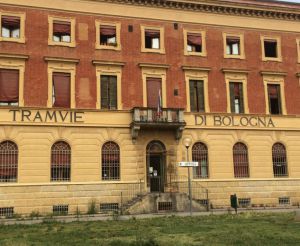Archaeological Museum, Bologna
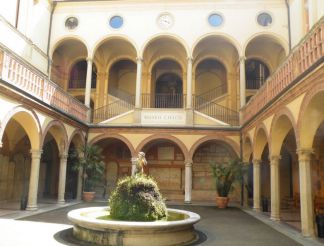
The Civic Archaeological Museum (Museo Civico Archeologico) offers its visitors a rich history of Bologna from the prehistoric times to the Roman Empire era. This prestigious city museum possesses collections that are one of the best in Italy. The collection of ancient Egyptian objects is considered to be of a great significance in Europe.
History of the museum
Today the museum is located in the ancient Palazzo Galvani. Its origins date back to 1336. Then the construction of the hospital complex and the church of Santa Maria della Morte began. In 1427 the church was consecrated, and over the centuries the complex became bigger and bigger. The most significant expansion was made by the architect Antonio Morandi who connected the building with the neighboring Archiginnasio in 1561. Before that, he designed a beautiful and grand portico.
During the Napoleonic occupation in 1798–1801 the hospital was closed. After that, a grandiose reconstruction was performed by the project of Coriolano Monti. The building started resembling a noble palace, a beautiful staircase appeared, the rooms were designed for the new owner. In the second half of the 19th century the building came into state ownership, and in 1875 it was decided to create a museum here. The palace halls were transformed once again, a garden with an elegant fountain was planted in the courtyard. In 1881, the City Archaeological Museum put its collections on display here.
Museum's collections
Museum collections were created on the basis of a powerful and old collection of archeological artifacts from the University of Bologna. A lot of pieces were added to them as a result of new once being discovered during excavations in the province. After they were put in the palace, the permanent exposition of the museum grew with time and now it includes about 200,000 exhibits. Most of them are of local origin, but there are also some findings from other regions of Italy. The whole collection is divided by theme, civilization and historical epoch.
- Prehistoric collection. It offers objects dating from the Lower Paleolithic to the Bronze Age. Among the exhibits, there are tools and items from different regions of the world which are made of bone, stone, and metals.
- Etruscan collection. Its core consists of pieces found in excavations in the province in the late 19th and early 20th centuries which help to replicate the development of the Etruscan civilization on the territory of Bologna. Basically, these are various objects from ancient tombs. Vases and other vessels of different materials, as well as very old and valuable exhibits, are predominant in this collection which is also filled with artifacts brought from central Italy.
- Gaul collection. It consists of objects from the necropolis of the Celts and Gauls who inhabited the province after the Etruscans.
- Lapidary collection. Includes tombstones and sculptures, the majority of them dates back to the Roman epoch (1st–2nd centuries). Plaster replicas of the famous Greek and Roman statues can be found here. The sculpture with the armor of Emperor Nero is particularly remarkable.
- Greek collection. This is a collection of ceramic artworks, precious stones and jewelry from ancient Greece. The highlight of the collection is a marble copy of the head of the statue called "Athena Lemnia" made by a sculptor named Phidias.
- Roman collection. It includes many sculptures, documents, artworks, glass, and ceramic vessels as well as objects and tools used in everyday life.
- Egyptian collection. This one boasts over 3,500 findings, such as sarcophagi, stele, ushabti and so much more. The most valuable are the bas-reliefs from the ancient tomb of the pharaoh Horehemba.
- Numismatic collection. The museum can rightfully take pride in this section, just like it does in the Egyptian one. It consists of around 100,000 coins, medals, medallions, and other items related to coins. Visitors will find a huge number of Roman coins of the republican and imperial periods, artworks created by medieval Italian mints as well as a collection of papal medals.
The museum also provides educational services. It houses a special library with a reading room, historical and photographic archives (available by appointment), workshops and laboratories, halls for temporary exhibitions, a conference room and a bookstore.
How to get
The museum is located in the historic center of Bologna, on Via dell'Archiginnasio, 2. It is surrounded by many noble palaces and ancient houses. Nearby there are also the Museum of the History of Bologna and Two Towers. The majestic Basilica of San Petronio faces the museum. The closest bus stops are Piazza Maggiore and Piazza Galvani (you can catch buses № 29, A, C, T2 there).
Opening hours: from Tuesday to Friday from 9:00 till 18:00; from Saturday to Sunday from 10:00 till 18:30. Closed on Mondays. The contact number for inquiries and booking: (+39) 051 275 7211.
Admission: the full ticket costs 6 euros. Visitors aged 18–25 and over 65, groups of 10 people can purchase a reduced one for 3 euros. Students and persons under 18 are free of charge. Entry is also free on the first Sunday of the month. The collections on the first floor are closed due to reorganization until March 2019, that’s why all visitors are charged only 3 euros. The information about admission and opening hours may be changed.



